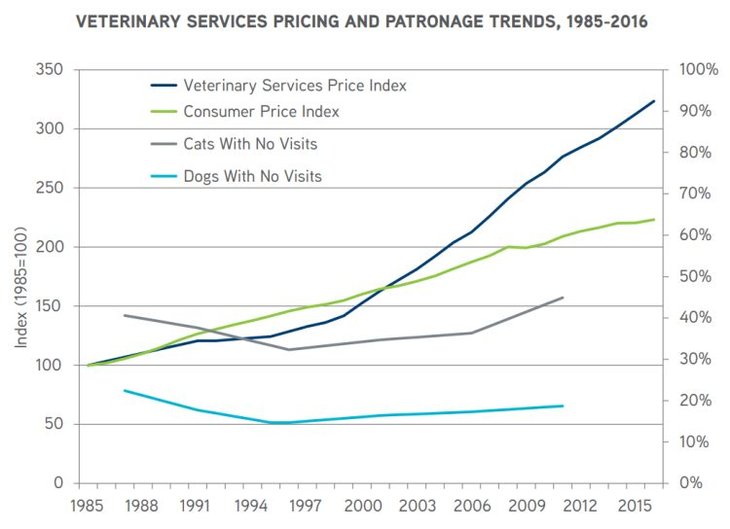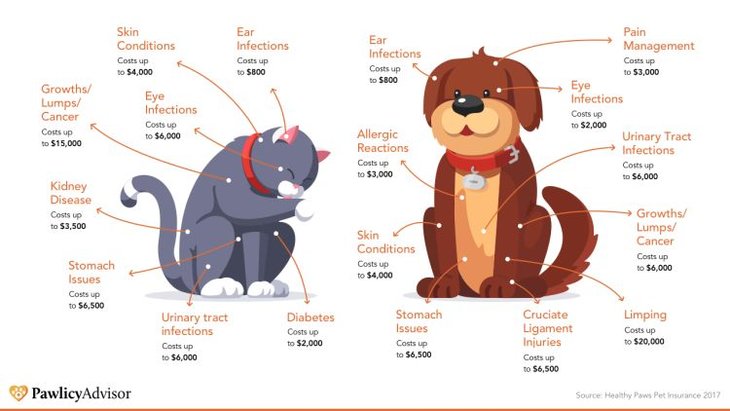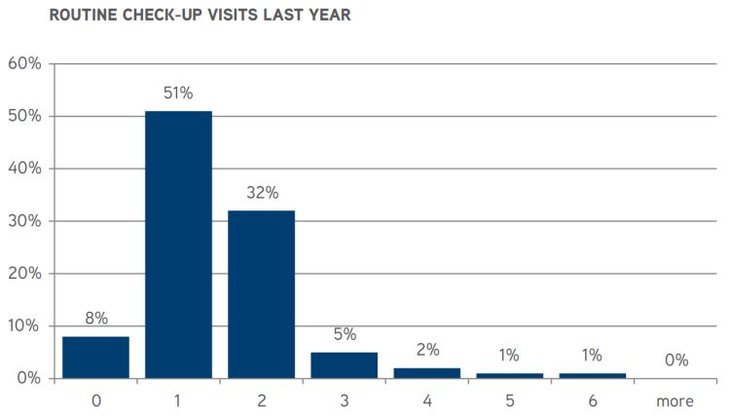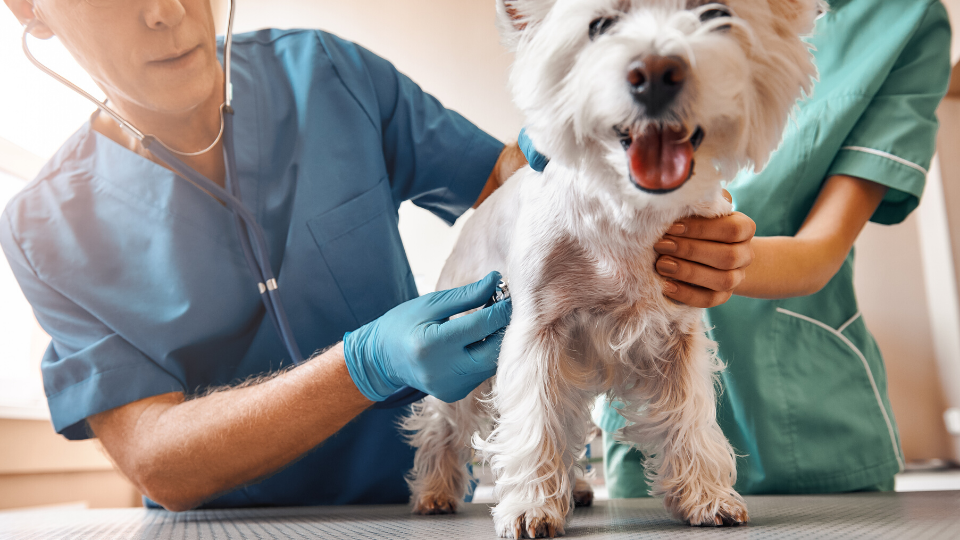How Much Does a Vet Visit Cost? Here's Everything You Need To Know
When you’re ready to adopt a pet, you may not always be thinking about their future veterinary costs. But it’s important to consider vet fees when working out your budget for caring for your pet over the next several years.
Not only will your pet need food, grooming, toys, and other supplies, but they’ll need to go to the vet at least once per year. You may also need to pay for emergency services if your pet gets hurt or sick, and those can add additional strain to your budget.
But how much does it cost to go to the vet? Unfortunately, the answer is: “it depends.” While most regular vet services can cost $100 or less, some procedures and treatments can cost thousands.
Looking to save on vet bills? See if pet insurance is right for you.
Instant results. No spam. 1M+ pet parents served.
"Pawlicy Advisor provided critical information to support my decision to invest in a pet health insurance policy and somehow found me the best pricing."
- Rambutan R, Pawlicy Customer
Looking to save on vet bills? See which pet insurance is right for you.
Instant results. 1M+ pet parents served.
⭐⭐⭐⭐⭐ 4.9 stars across hundreds of reviews.
As a pet rescue and foster who works with a pet rescue nonprofit in Brooklyn, I've seen my fair share of veterinary bills - ranging from low-cost "mom-and-pop" practices to higher-end practices with state-of-the-art diagnostics and surgeons.
Here, I’ll break down what you can expect when taking your pet to the vet:
- The basic costs involved in a vet visit
- Standard veterinary expenses
- How pet type can influence the costs of a vet visit
- How breed can influence vet costs
- What to expect from a visit to the vet
- Potential fees associated with emergency vet visits
- How to cover veterinary costs without depleting your savings
The Basic Cost of a Vet Visit
According to the American Veterinary Medical Association (AVMA), the price of veterinary services has been rising steadily since the turn of the millennium. In 2016, the Veterinary Services Price Index was outpacing the Consumer Price Index by more than 25 percentage points.
Pet ownership is increasing, and the costs of veterinary care are also on the rise.
Veterinary care is in much higher demand than it ever was, in part because pet owners are treating their pets differently. In one study, 95% of pet parents consider their pets a part of their family. People are spending more on their pets, and they’re more willing to bring them to the vet for regular checkups.

A Breakdown of Standard Veterinary Expenses
Vet expenses vary widely depending on what services your veterinarian is providing. Veterinary practices charge for services like physical exams, diagnostic services, lab work, surgical procedures, anesthesia, hospitalization, and even overnight boarding.
Many of these services can be covered by pet insurance, which would reimburse a percentage of your out of pocket expenditures after you pay your vet.
An appointment for surgery will cost much more than a wellness visit, and regular treatments, such as those for cancer, can add up to a considerable sum over time. Here are some of the most common veterinary services and how much they typically cost.
Tests, Examinations, and Initial Vet Costs:
- Routine checkups: $50 to $250
- Spay/neuter: $160 to $220
- Vaccines per shot: $15 to $28
- Physical exams: $45 to $55
- Fecal exam: $25 to $45
- Heartworm test: $45 to $50
- Dental cleaning: $70 to $400
- Allergy testing: $195 to $300
- Geriatric screening: $85 to $110
Surgeries and Unexpected Vet Costs*:
- Bloodwork: $80 to $200
- X-rays: $150 to $250
- Ultrasounds: $300 to $600
- Short hospitalizations: $600 to $1,700
- Long hospitalizations: $1,500 to $3,500
- Wound treatment: $800 to $2,500
- Emergency surgery: $1,500 to $5000
- Oxygen therapy: $500 to $3000
(*Based on estimates by Emergency Vets USA)
Again, these prices may vary depending on where you live, what type of animal you have, what breed you have, and their health history. Even a routine exam fee can vary state-by-state. According to the ASPCA, recurring medical expenses for a dog can range from $210 to $260 depending on their size.

The good news is that you can lower the costs of these services significantly with pet insurance. For example, if you have a pet insurance plan that reimburses you for 90% of covered costs, that $5,000 emergency surgery could end up costing you just $500 out of pocket.
Pet insurance lowers out-of-pocket vet costs.
Plans can reimburse 60-100% of eligible expenses.
Average Vet Costs for the First Year of Owning a Dog or Cat
The APSCA estimates that the first year of owning a dog can cost as much as $2,000 or more, depending on the size of the animal. Meanwhile, the cost of owning a cat can cost up to $1,174 on average.
However, these costs are assuming you’ll only need to bring your pet in for regular visits and won’t have any unexpected charges on your vet bill. If a regular visit costs about $250 and you bring a new dog to the vet only once, the rest of your spending can go to supplies like food, toys, and treats.
If your pet needs some of the unexpected services listed above because they develop an illness or need additional tests, you could end up paying substantially more out of pocket if you don’t have pet insurance.
How Pet Type Can Influence the Costs of a Vet Visit
It’s difficult to nail down the costs of vet care because veterinary medicine differs depending on the type of pet you own. Caring for a smaller animal like a cat or rabbit is generally much less expensive than caring for a large or medium-sized dog — or a horse, for that matter.
Today’s pets are also living longer than ever thanks to advances in medical care and better pet diets. If you have an older pet, you can expect to have higher veterinary costs because pets tend to need more care as they age. Older pets should get regular veterinary examinations so your vet can check for problems.
AVMA notes that “while it’s easy to spot the outward signs of aging such as graying haircoat and slower pace, it’s important to remember a pet’s organ systems are also changing. An older pet is more likely to develop diseases such as heart, kidney and liver disease, cancer, or arthritis. Dogs get cancer at roughly the same rate as humans, while cats have a somewhat lower rate.”
Other factors that can influence veterinary costs are your pet’s weight, health history, and temperament. For example, if your dog is overly aggressive when you bring them to the vet, you may need to give them medication to keep them calm and muzzle them. In some cases, the vet may need to sedate your pet so they can examine them, which can add to your costs.
How Breed Affects Veterinary Costs
The breed of your pet also impacts veterinary costs. When discussing breed, we’re generally discussing dogs.
There are over 190 recognized dog breeds in the United States and only 42 cat breeds. This is partially due to the history of dog breeding and how dogs were used as herders, hunters, and other types of working animals in the past. Still, some cat breeds do have fewer health issues than others.
Many pet insurance plans cover breed-specific issues. If you have a pet breed that tends to have certain conditions, investing in pet insurance could help significantly if those conditions arise.
Some common breed-specific conditions include the following:
- ACL tears
- Bladder stones
- Brachiocephalic syndrome (due to narrow nasal passage)
- Cancer
- Ear infections
- Hip dysplasia
- Knee and elbow dislocations
- Slipped discs
If you’re unsure about your pet’s breed-specific conditions, ask your veterinarian about what you can expect.
What to Expect From a Visit to the Vet
A typical visit to the veterinarian can cost as little as $50 depending on the pet being examined and their needs. But, as we mentioned before, those costs can go up if your pet has an unexpected illness or if they need other types of routine care.
Your First Visit
On your pet’s first visit, your veterinarian will conduct a general health screening and wellness exam. This initial appointment is a crucial part of primary vet care. They’ll enter your pet’s information into their records. You can expect them to do the following:
- Weigh your pet
- Listen to their heart and lungs
- Take their temperature
- Check their ears, eyes, and genitalia
- Examine their teeth and mouth
- Examine their feces (you may need to bring a sample)
- Give your pet vaccinations (if necessary)
- Test for common diseases (if necessary)
- Determine your pet’s vaccination schedule
The Wellness Exam
Similar to an initial health screening, a wellness exam determines the overall health of your pet. Your regular veterinarian will do a physical examination of your pet, but they’ll also ask you questions about your pet’s behavior, diet, and lifestyle patterns.
A basic vet visit might cost $50, but expenses quickly add up with illnesses and injuries.
For example, it’s normal for dogs to curl up and sleep throughout the day, but if your dog is acting particularly lethargic, this could be a symptom of an underlying condition. Your vet would need to know about this behavior.
Similarly, even the healthiest cats will vomit from time to time. But if they are vomiting often — more than once or twice per week — it could indicate a health condition. This is why it’s important to be completely open about your pet’s behavior with your vet.
Once your veterinarian has assessed the wellness of your pet, they’ll discuss preventative steps you can take to avoid problems. They may recommend you use preventive treatments for fleas, ticks, intestinal parasites, and heartworm. They’ll go over your pet’s nutrition needs, weight management, what pet food you should use, dental care, and more.
Scheduling Routine Check-Ups
Most veterinarians recommend you bring your pet to them at least once per year, but preferably more. Unfortunately, some pet parents bring their pets to the vet less often.
According to a study by the AVMA, about 8% of pet parents don’t bring their pets in for routine checkups once per year. Still, 51% bring them in once per year and the remaining 41% bring them even more often.

Over 50% of pet owners took their pet to the vet for a routine checkup at least one time in the previous year.
A routine check-up will typically involve a physical examination, a wellness check, and vaccine booster shots, if necessary. If you want to be reimbursed for this kind of routine care, you'll need a wellness plan.
Unexpected Veterinary Costs
If your veterinarian discovers anything out of the ordinary during your pet’s first visit or a subsequent wellness exam, they may wish to do additional tests to determine what’s wrong with your pet.
Generally, veterinarians will only do additional testing if they need to narrow down the possibilities of your pet’s condition to make an accurate diagnosis. Don’t hesitate to ask about the costs of testing beforehand. Once your veterinarian is confident in their diagnosis, they’ll discuss plans for treatment with you.
If your pet is sick or injured, you’ll have to pay some unexpected veterinary costs. This is where pet insurance is essential. Depending on the severity of your pet’s condition, you could have to pay thousands of dollars out of pocket to treat your pet.
If your pet needs life-saving care, they may be admitted to an animal hospital overnight. You’ll need to pay for the boarding of your pet, for any tests conducted to determine what’s wrong, as well as for treatment to make your pet better.
Pet insurance coverage means you only have to pay for a fraction of what you’d normally owe in vet bills.
Health Issues & Vet Costs to be Aware of
- Parvovirus
- Cataracts
- Dog Teeth Cleaning
- Kennel Cough
- Heartworm Disease
- Lyme Disease
- Leptospirosis
- Dog X-Ray Costs
Potential Fees Associated with Emergency Vet Visits
An emergency visit occurs when your pet needs immediate or life-saving care and they can’t wait until regular business hours for an appointment. Thankfully, many veterinary clinics and animal hospitals provide out-of-hours veterinary care for emergencies. If you’re a new pet owner, you should identify your nearest emergency clinic just in case.
If your pet has an emergency, contact your veterinary emergency services provider immediately and speak to the person on-duty. They’ll give you advice over the phone, or they’ll suggest you bring your pet in for treatment.
After your pet is examined, the emergency care vet will discuss whether they need to do additional tests or whether you can move on to treatment. It’s at this point that your costs will begin to go up.
Emergency veterinary fees are typically higher than fees associated with regular care. According to Preventive Vet, a typical emergency visit may involve the following fees:
- ER exam: $75 - $125
- IV catheter: $60 - $75
- IV fluids : $50 - $75
- Blood tests (basic): $75 - $150
- Urine tests (basic): $25 - $50
- X-rays (basic): $75 - $250
- Blood pressure measurement: $25 - $75
- Pain medication: $40 - $80
- Hospitalization / Vet Tech Monitoring: $50 - $200
TOTAL: $475 - $1,080
This is not including any additional costs for treatment, which is dependent on your pet’s condition. This is why the costs of emergency veterinary care vary so much. It’s also the reason financing options and pet insurance are so important during emergencies.
How To Cover Veterinary Costs Without Depleting Your Savings
Clearly, comparing pet insurance options is a must. With a comprehensive pet insurance plan, you won’t have to worry about choosing between your pet’s emergency care and breaking your bank. Good coverage ensures you can get them the care they need right when they need it and gain peace of mind in knowing your prepared for an emergency (even for rescue pets).
However, pet health insurance works differently than human health insurance. Most pet insurance providers pay you, the policy holder, instead of the practice or doctor. That means you don't have to worry about find a veterinarian who's "in-network", you can go to any vet you please and get reimbursed just the same - but that also means that you will generally have to pay the cost upfront while you wait for your reimbursement.
Ideally, you should pay for the upfront vet cost on a credit card with a good rewards incentive. For example, if your credit card offer 3% cash back on purchases, by using that card to pay the initial bill you'll be effectively reducing the cost by 3%. Then, in just a few days your pet insurance provider will reimburse you for the bill and you can pay off that credit charge with the reimbursement.
For example, let's pretend you have a policy with 90% reimbursement and a $250 deductible...
Your vet bill is $1237, you put it on your credit card which give 3% cash back. Your plan reimbursed you for 90% of the cost after the deductible is met. In this case, let's say it's the first vet cost of the year so your $250 deductible is not yet met. Eight days after paying your vet bill your pet insurance provider reimburses you $888.30 (or ($1237 - $250)*0.9).
Your total cost would then be: $1237 - $888.30 - (3% back on $1237) = $311.59
That's a massive savings. And, if another issue arises your deductible is already paid for that year so you'll simply be reimbursed 90% (or what ever your policy indicates) on your next bill.
For example, vet bill #1 cost $1237 but it only cost you $311, then vet bill #2 comes in for $600 but it only costs you $42! Since your deductible was paid for in vet bill #1, you'll be reimbursed 90% of the full vet bill #2 plus 3% back on the initial bill (if you used a credit card with that reward rate)... $600 - 90% (or $540) - 3% (or $18) = $42.
This way, your bank account goes untouched and your savings are maximized.
Just make sure you get the right pet insurance policy at the best price, no matter the provider.
Do you want to find the best pet insurance?
Let's analyze your pet's breed, age, and location to find the right coverage and the best savings. Ready?
Analyze My PetAbout Pawlicy Advisor
The pet insurance marketplace endorsed by veterinarians, at Pawlicy Advisor we make buying the best pet insurance easier. By comparing personalized coverage and pricing differences we can save you a ton of money, up to 83% in some instances!
Instantly Compare Pet Insurance Plans
Guides
Determine If Pet Insurance Is Worth It
Comparison Charts
Find Your State
Dog Insurance
Director of Marketing & Foster/Rescue Parent - Pawlicy Advisor
Edwin Plotts rescues and rehomes cats in Savannah, GA - while leading Pawlicy Advisor's brand growth. He's a pet parent of two rescued sibling cats: Greyson and Babs. He's also an avid volunteer with Flatbush Cats and The Toby Project.
